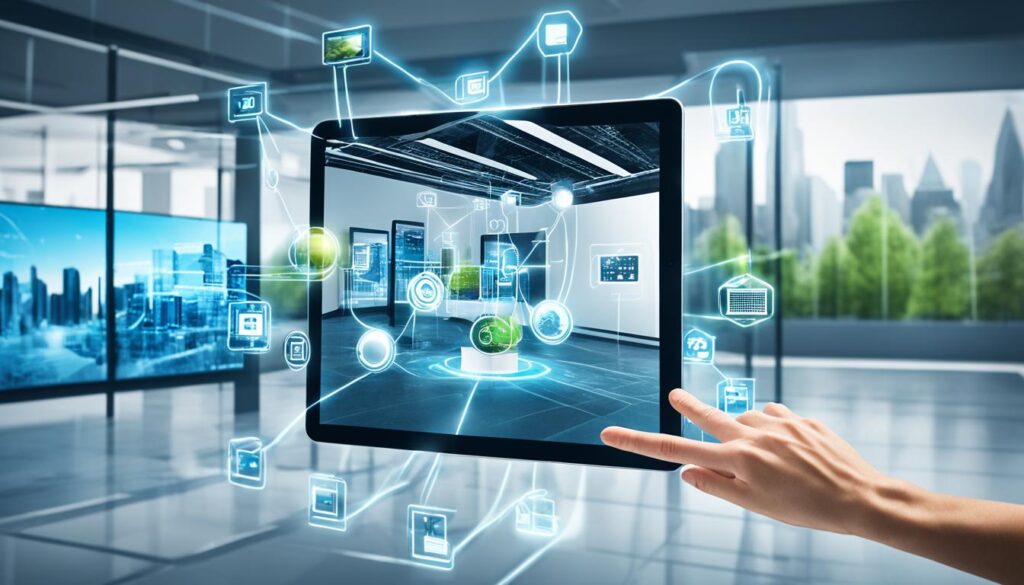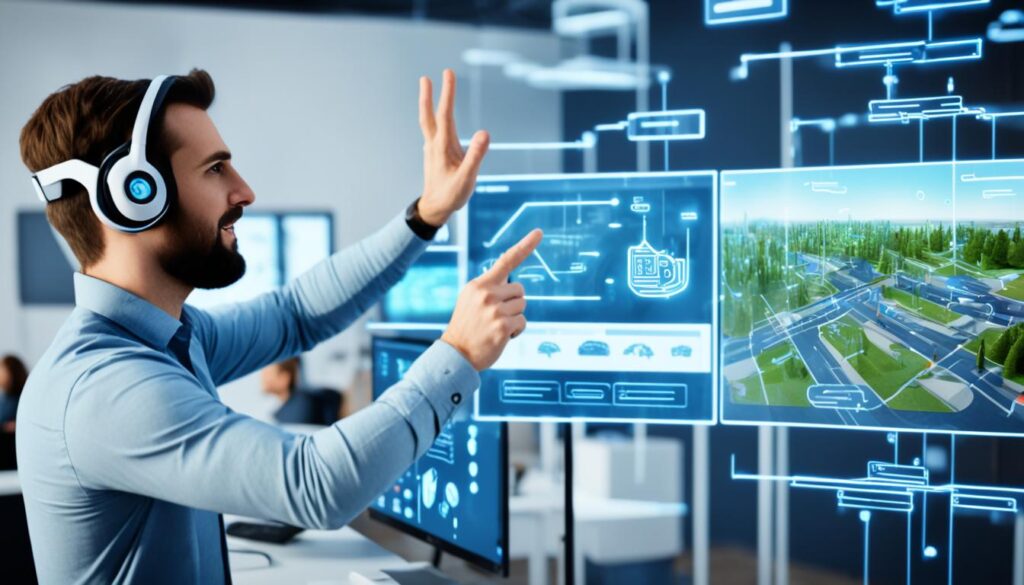Technology is changing fast, and augmented reality (AR) is a big change in app development. AR mixes the digital and real worlds. This lets developers make experiences that grab users and change how we use digital stuff.
This article looks at how to make AR apps. It covers the important parts, platforms, and design tips for making AR apps. It’s for both experienced developers and those new to AR. This guide will help you make AR experiences that really stand out.
Table of Contents
Key Takeaways
- Understand the basics of augmented reality and its role in app development today.
- Learn about the main parts needed for AR experiences, like 3D models, tracking objects, and designing the user interface.
- Find out about different AR platforms and frameworks. See how to pick the best one for your project.
- Get tips on making AR experiences that are easy to use and fun for your audience.
- Learn how to add AR to your apps to make them more engaging and interactive.
Augmented Reality: Blending Digital and Physical Worlds
Augmented reality (AR) is a cool tech that mixes digital stuff with the real world. It’s different from virtual reality (VR), which takes you into a made-up world. AR adds virtual things like 3D models or info to what we see in real life.
AR technology combines the digital and physical worlds for a fun experience. It lets users touch and interact with virtual objects in a real way. This makes the line between the virtual and real worlds fade away.
The key idea behind AR is to blend digital and physical worlds. AR uses special devices like phones or tablets to see and place virtual things in the real world. This mix of digital and real is what makes AR special.
AR has many uses, like making shopping better, helping with learning, and changing how industries work. It adds digital info to the real world. This changes how we see and interact with our surroundings, making the virtual and physical worlds closer together.
| Augmented Reality | Virtual Reality |
|---|---|
| Blends digital content with the physical world | Fully immerses the user in a computer-generated environment |
| Enhances the real-world experience | Replaces the real-world experience |
| Uses specialized hardware like smartphones, tablets, or wearables | Requires dedicated VR headsets and controllers |
| Overlays virtual elements on the user’s view of their surroundings | Completely replaces the user’s visual and auditory inputs |
As AR gets better, it’s changing how we see the world. It’s bringing the digital and physical together in new ways.
The Power of Augmented Reality in App Development
Augmented reality (AR) is changing the app development world. It’s making user experiences better and opening new doors in many industries. AR mixes digital stuff with the real world. This lets developers make apps that grab users and bring big benefits.
Redefining User Experiences
Augmented reality in app development changes how people use their phones. AR apps can add virtual things to the real world. This makes apps more fun and easy to use.
Users can see products, get info, and check out digital stuff in a new way. This makes using apps more natural and fun, redefining user experiences with AR.
Applications Across Industries
AR use cases in different industries are amazing. It’s used in retail, education, healthcare, and more. AR apps make seeing products better, help with learning, give info on the spot, and make working together easier.
The benefits of AR in app development are huge. It’s becoming key for those who want to lead and innovate.
| Industry | AR Use Cases |
|---|---|
| Retail and E-commerce | Virtual product try-on, interactive product visualizations, augmented showrooms |
| Education | Immersive learning experiences, interactive 3D models, virtual field trips |
| Healthcare | Surgical planning and guidance, remote patient monitoring, anatomy visualization |
| Manufacturing | Augmented assembly instructions, real-time data overlays, remote assistance |
The benefits of AR in app development keep growing. Developers who use this tech will make apps that wow users and succeed in many areas.
Key Components of an Augmented Reality App
Creating a great AR app needs several important parts. At the core, 3D modeling and animation, along with object tracking and recognition, are key. These elements make AR experiences immersive.
3D Modeling and Animation in AR
Realistic virtual objects are key for a smooth AR experience. 3D modeling and animation help make digital assets that look real. They make things like product demos and interactive holograms come to life, making the experience better for users.
Object Tracking and Recognition Techniques
Object tracking and recognition are also vital for AR apps. These technologies help AR apps work with real-world objects. They let users easily interact with virtual content that’s superimposed over the real world.
| Key Components of AR Apps | Description |
|---|---|
| 3D Modeling and Animation | Creates digital assets that look real and blend well with the real world, making the experience better. |
| Object Tracking and Recognition | These advanced techniques help AR apps work with real objects, making virtual content interactive. |
“The integration of 3D modeling, animation, object tracking, and recognition technologies is essential for creating truly immersive and interactive augmented reality experiences.”
By focusing on these key areas, AR app developers can make the most of augmented reality. This leads to new innovations and better experiences in many industries.
Augmented Reality in App Development
Adding augmented reality (AR) to mobile apps is a detailed process. It needs careful planning and execution. The AR app development process includes key steps from the start to the end.
The first step is ideation. Here, developers and designers think of ways AR can make the app better. They look at how AR can add special value and think about the technical side of it.
Then, the team starts with prototyping. They make 3D models and work on tracking and recognizing objects. They test how AR fits into the app’s features. This phase lets them try out ideas, improve them, and check if the AR concept works.
In the development stage, the AR app starts to take shape. Developers make sure the AR parts work well with the app. They use advanced computer vision and solve any technical problems that come up.
The deployment phase is when the app is tested, approved, and shared with users. Keeping the app updated and maintained is key. This ensures the AR features keep working right and users have a good experience.
Adding AR to apps is a big task but also very rewarding. By following a clear plan and using the latest AR tech, developers can make apps that blend the digital and real worlds in exciting ways.
| Stage | Description |
|---|---|
| Ideation | Brainstorming ideas for how AR can enhance the app and provide value to users |
| Prototyping | Creating 3D models, developing object tracking and recognition, and testing the AR integration |
| Development | Seamlessly incorporating the AR components into the mobile app, ensuring a cohesive user experience |
| Deployment | Thoroughly testing the AR-enabled app, obtaining necessary approvals, and making it available to users |
| Maintenance and Updates | Ensuring the AR features continue to function correctly and provide a positive user experience |
Choosing the Right AR Development Platform
The augmented reality (AR) market is growing fast. Choosing the right platform to make AR experiences is key. Developers need to look at the pros and cons of native and cross-platform AR frameworks.
Native vs. Cross-Platform AR Frameworks
Native AR platforms like Apple’s ARKit and Google’s ARCore give better performance and work well with the device. They use the device’s hardware for a smoother AR experience. But, making apps for these platforms takes time and needs special skills for each device.
Cross-platform AR frameworks, such as Unity and Unreal Engine, let developers make AR apps for many platforms. These can run on iOS, Android, and even the web. This makes making apps faster and easier, but might mean less performance and fewer device features.
| Native AR Frameworks | Cross-Platform AR Frameworks |
|---|---|
|
|
When picking an AR platform, think about who you’re making it for, what you need, your team’s skills, and how much performance and customization you want. This way, you can make sure your AR app is engaging, meets your goals, and fits your technical needs.
Designing Intuitive and Engaging AR Experiences
Making AR experiences that are both fun and easy to use is key in AR app development. Designers need to blend virtual and real-world elements smoothly. They should focus on easy interactions and knowing the space to make experiences that grab users’ attention.
UI Considerations for AR Apps
Creating a good user interface (UI) for AR apps is tricky. Developers must balance digital and real-world interactions for a smooth flow. Important things to think about include:
- Spatial Awareness: Know what the user sees and place virtual stuff well for the best view and context.
- Intuitive Interactions: Use natural gestures and movements for easy interactions with virtual objects, keep controls simple.
- Minimalist Design: Keep the UI clean and focus on what’s really needed to not overwhelm the user.
- Adaptive Layout: Make sure the UI changes with different screen sizes, orientations, and settings for a consistent feel.
By focusing on these UI considerations for AR apps, designers can make intuitive and engaging AR experiences. These experiences mix the digital and real worlds smoothly.
| Best Practices for AR App Design | Key Considerations |
|---|---|
| Spatial Awareness | Understand the user’s environment and optimize virtual content placement |
| Intuitive Interactions | Leverage natural gestures and movements for seamless interactions |
| Minimalist Design | Maintain a clean, uncluttered UI with essential features and controls |
| Adaptive Layout | Ensure the UI can adapt to different screen sizes and environmental conditions |
Using these best practices for AR app design, developers can create designing AR user experiences. These experiences will draw users in and make them feel part of both the digital and real worlds.
Integrating AR into Your Existing Apps
Augmented reality (AR) can make your mobile apps more exciting and immersive. By adding AR to your apps, you can make them stand out. This makes your app more fun and engaging for users. Adding AR to your apps can also make them more useful and unique.
AR can make your apps better by adding new features. For example, you can show digital things like 3D models or interactive pictures in the real world. This is great for retail apps, letting users try on clothes or see products in their own space.
AR can also give users more information in your apps. For instance, in a navigation app, AR can show directions or interesting places right in front of you. This makes it easier to get around and discover new things.
| Industry | AR Integration Use Cases |
|---|---|
| Retail | Virtual product try-on, visualizing products in user’s space |
| Navigation | Overlaying directions and points of interest on the real-world view |
| Education | Enhancing textbooks and learning materials with interactive 3D models |
Adding AR to your apps needs careful thought and planning. Make sure the AR parts are easy to use and really help the user. This way, you can make an app that grabs attention and stands out.
“The key to successful AR integration is to enhance the user experience, not distract from it. By thoughtfully incorporating AR features, you can unlock a new level of interactivity and engagement for your users.”
Creating Immersive AR Games and Entertainment
Augmented reality (AR) has changed the way we play games and enjoy entertainment. It combines digital elements with the real world. This creates experiences that pull us in and keep us coming back for more.
Gamification and Storytelling
AR uses gamification and storytelling to make experiences unforgettable. By adding game-like features, AR apps make us want to keep playing. Stories and characters draw us into the game, making it feel real.
Developers focus on a few key things to make AR games great:
- Seamless integration of virtual objects and characters with the real-world environment
- Intuitive and intuitive user interfaces that enhance the AR experience
- Engaging storytelling and game mechanics that keep users invested and entertained
- Optimization for various platforms and devices, ensuring a consistent and high-quality experience
By using these strategies, AR developers can create experiences that change how we see the world. These experiences are memorable and redefine how we interact with our surroundings.
| Aspect | Description |
|---|---|
| Seamless Integration | Seamlessly blending virtual objects and characters with the real-world environment to create a cohesive and immersive experience. |
| Intuitive UI | Designing user interfaces that are intuitive and enhance the overall AR experience, making it easy for users to interact with the digital elements. |
| Engaging Storytelling | Crafting captivating narratives and game mechanics that keep users invested and entertained, fostering a sense of immersion and motivation. |
| Platform Optimization | Ensuring the AR experience is optimized for various platforms and devices, providing a consistent and high-quality experience across different environments. |
“Augmented reality has the power to transform the way we experience entertainment, blurring the lines between the physical and digital worlds.”
Augmented Reality in Retail and E-Commerce
Augmented reality (AR) is changing how businesses talk to their customers. It’s making shopping online and in stores more fun and personal. AR is breaking down the line between the digital and real worlds.
In AR in retail and e-commerce, stores use this new tech to make shopping better. Now, customers can try on virtual clothes at home before buying them. They can also see more about products in stores with AR.
AR-powered shopping experiences are changing the game. They make customers more engaged, help reduce returns, and boost sales. This tech mixes the best of online and in-store shopping. It makes shopping more personal and fun for everyone.
“Augmented reality is revolutionizing the retail industry, allowing businesses to offer unique, engaging, and personalized shopping experiences that bridge the gap between the digital and physical worlds.”
As AR becomes more popular in shopping, businesses that use it will stand out. They’ll grab their customers’ attention and keep them coming back.
AR in Education and Training
Augmented reality (AR) is changing the way we teach and train. It mixes digital info with the real world. This makes learning fun and interactive, improving how well students do and how much they enjoy it.
Enhancing Learning Outcomes
AR is making learning exciting and effective. Using AR to enhance learning outcomes, teachers can create simulations and activities that make hard topics easy to understand. This way, students learn better and remember more.
- Engage students with interactive 3D models and animations
- Provide real-time feedback and personalized learning experiences
- Facilitate experiential learning through simulations and virtual experiments
- Enhance spatial awareness and understanding of complex subjects
| Benefit | Impact |
|---|---|
| AR in education and training | Improved learning outcomes, increased engagement, and enhanced comprehension of complex topics |
| AR-powered educational and training experiences | Immersive and interactive learning opportunities that bridge the gap between theory and practice |
By using AR in education and training, teachers can make learning fun and effective. AR works well with many subjects, from science to arts. It helps students learn in new and exciting ways.
“AR has the power to transform the way we approach education and training, creating more immersive and personalized learning experiences that ultimately lead to better outcomes for students and trainees.”
Augmented Reality in Healthcare
The healthcare industry is changing fast with AR technology. AR is making a big difference in medical training and patient care. It’s changing how healthcare is delivered.
AR is a big deal in medical education and training. It lets doctors see inside the body, practice surgeries, and go through emergency scenarios in a real-like setting. This makes learning more engaging and helps trainees gain skills and confidence.
AR-powered medical apps are also changing patient care. They give doctors real-time info. AR helps doctors see patient records and guide them during surgeries. This leads to better decisions and outcomes for patients.
AR is doing more than just helping with training and patient care. It’s used in rehab and physical therapy too. Patients can do exercises and track their progress. AR also helps with remote patient monitoring, making care more personal at home.
“Augmented reality is transforming the healthcare industry, empowering medical professionals and improving the quality of patient care.”
As more people use AR in healthcare, we’ll see more AR-powered medical apps. These apps will make healthcare better. AR is making healthcare more efficient, personal, and focused on the patient. It’s changing how we get and experience medical care.
AR for Navigation and Wayfinding
Augmented reality (AR) changes how we navigate indoors and outdoors. It mixes digital info with the real world. This makes AR navigation and wayfinding better for users and helps us understand our surroundings better.
Indoor and Outdoor Navigation
Inside, AR shows maps, navigation paths, and markers to help us find our spot and the best way to go. It uses sensors, WiFi, Bluetooth beacons, and visual SLAM for accurate tracking and directions. This makes navigating complex places easy.
Outside, AR works with GPS and other services to add directions, places of interest, and info to what we see. This AR-powered outdoor navigation makes finding our way more natural and fun.
“Augmented reality has the potential to revolutionize the way we navigate and find our way, both indoors and outdoors.”
For AR navigation to work well, it needs to be easy to use, tested well, and updated often based on what users say. This way, AR apps can really make a difference in how we navigate and understand our surroundings.
Augmented Reality in Manufacturing and Industrial Applications
Augmented reality (AR) is changing the game in manufacturing and industry. It blends digital info with the real world. This helps workers do their jobs better, makes things more efficient, and boosts productivity in many industrial areas.
AR makes fixing and repairing things easier. It gives step-by-step guides, 3D visuals, and live data. This lets technicians find and fix problems fast, cutting down on downtime and making equipment work better.
AR is also a big help in checking quality and making sure things are right. It puts digital info on real products. This way, manufacturers can check for mistakes, spot defects, and make their products better.
Training and learning new skills are also getting a boost from AR. AR training lets workers practice complex tasks safely. This means they learn better and do their jobs better too.
AR has many uses in manufacturing, like making supply chains run smoother and keeping workplaces safe. It gives real-time data and visual hints. This helps with logistics, cuts down on mistakes, and makes safety rules better. It makes everything work more efficiently.
AR is becoming more popular in manufacturing and industry. Its potential to change how we do things is huge. By using AR, companies can get more efficient, productive, and safe. This puts them ahead in a tough market.
The Future of Augmented Reality in App Development
The world of technology is always changing, and augmented reality (AR) in app development is no exception. AR is set to change how we use digital content, mixing the real and virtual worlds together.
AR-powered apps are expected to get better with new hardware and software. We’ll see more powerful, yet lightweight, AR devices. These will make AR experiences more real and fun.
AR will also move beyond games and fun apps. It will change how we shop, learn, get medical help, and work in factories. Imagine trying on clothes without buying them, seeing how surgeries work, or finding your way in a factory with AR.
As AR grows, we’ll see more apps that focus on what users need. AR will make everyday tasks easier and change how we see the world. It’s set to make mobile experiences much more exciting.
| Emerging Trends in AR App Development | Potential Impact |
|---|---|
| Advancements in AR hardware and software | More immersive and seamless user experiences |
| Expansion of AR applications beyond entertainment | Transformative impact on industries like retail, education, healthcare, and manufacturing |
| Increased focus on user-centric design and intuitive interactions | Enhanced engagement and adoption of AR-powered apps |
Looking ahead, AR will be key in changing how we use digital content and see the world. It will bring new trends and advancements that will change our lives, work, and fun.
“The future of augmented reality in app development is not about technology, but about how we use it to enhance the human experience.”
Conclusion
Augmented reality has changed the game in app development. It’s now a key way for users to interact with digital content. It mixes the real world with the virtual, opening up new possibilities for app makers and businesses.
This article showed how AR changes user experiences and its importance in app development. It also highlighted its uses in different industries. By using the right AR tools and creating engaging experiences, developers can make apps that stand out and leave a lasting impression.
The future of AR in app development looks exciting. With new breakthroughs and growing user interest, the chances for developers to make a mark with AR will keep getting bigger. The journey ahead is full of potential to change how we use digital content.














